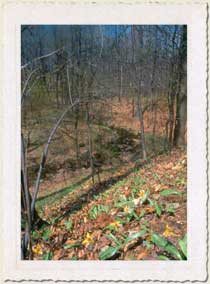
Wolfe's Pond Park Preserve
Borough: Staten Island
Acres: 207
Habitat Type: Forest, Freshwater Wetland
Map: PDF
Wolfe’s Pond Park contains mature upland woods, swamp forest, open marsh, ponds, and shoreline on Raritan Bay, making it one of the most diverse parks in the city. This large park is a refuge for scores of native plants and animals in a rapidly developing area of the city. The beach is part of the shoreline strand that runs continuously from Ward’s Point in Conference House Park, north through Mount Loretto and Lemon Creek Preserve, to Wolfe’s Pond Park.
The land beneath Wolfe’s Pond Park was carved during the last ice age. The melting Wisconsin ice sheet transported clay, sand, and gravel south and deposited them along the shores of Staten Island, forming the beach at Wolfe’s Pond Park. The freshwater Wolfe’s Pond was once a tidal inlet, but the gradual action of wind and waves pushed sand and clay into the mouth of the inlet, damming it and forming a pond. Wolf’s Pond is connected by a stream to Acme Pond, which was formed as the ice sheet retreated, leaving a large chunk of ice behind. This ice melting to form a permanent depression filled with water: a kettle pond.
Every May and June, horseshoe crabs (Limulus polyphemus) emerge from the Raritan Bay to breed on the beaches of Wolf’s Pond Park. In the spring, common yellowthroats (Geothylpis trichas), redstarts (Setophaga ruticilla), and other warblers forage in the thickets at the pond edge and in the surrounding forest. Wood ducks (Aix sponsa) and mallards (Anas platyrhychos) feed and nest among aquatic plants such as arrow arum (Peltandra virginica), swamp rose mallow (Hibiscus moscheutos), and buttonbush (Cephalanthus occidentalis). Red-winged blackbirds (Agelaius phoeniceus) are conspicuous members of the pond community. Black-crowned night herons (Nycticorax nycticorax), great blue herons (Ardea herodias), and belted kingfisher (Ceryle alcyon) hunt for fish and frogs along the pond edge.
The edges of Acme Pond are less disturbed than Wolfe’s Pond because they have been protected by swampy conditions. This allows skunk cabbage (Symplocarpus foetidus), tussock sedge (Carex stricta), and cinnamon fern (Osmunda cinnamomea) to grow. Opossums (Didelphis marsupialis) and raccoons (Procyon lotor) roam the wood and forage around the edges of the pond. A variety of reptiles, amphibians and fish also reside at Acme Pond, including painted turtles (Chrysemys picta), snapping turtles (Chelydra serpentina), red-backed salamanders (Plethodon cinereus) and several types of bass and carp.
Directions
By Rail: Take Staten Island Ferry to St. George. From Ferry terminal, take Staten Island Rapid Transit to Prince’s Bay (Seguine Avenue). Walk south on Seguine. An entrance to the northern side of the park is on the right at the end of Florence Place. To reach the southern end of the park, walk south on Seguine to Hylan Blvd. Turn left on Hylan, and walk to Cornelia Avenue. Turn right on Cornelia, the park entrance is on the right. The walk from the train station to the south entrance of the park is about 2 miles.
By Bus: From St. George take the S 78 (Amboy Rd./ Main Street) bus to Luten Avenue and Hylan Blvd. Walk one block west to Cornelia Avenue. Turn left on Cornelia. The park entrance is on the right.
By Car: From St. George take Victory Blvd south to Slossen Avenue. Turn left onto Slossen. After 2 traffic lights turn right to Route 278 entrance, Staten Island Expressway South. Take the Expressway to Route 440. Follow the signs for the Outerbridge Crossing/New Jersey. Exit Route 440 at Exit 1, Arthur Kill Road. This is the last exit before the bridge. Turn right at the stop sign at the end of the exit ramp. Take the first right, Tyrellan Avenue, to cross over the highway. Turn right onto Page Avenue. Follow Page Avenue to Hylan Boulevard. Turn right onto Hylan and follow the road to Cornelia Ave. Turn right, the park entrance is on the right.
